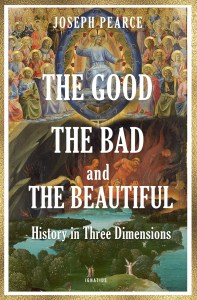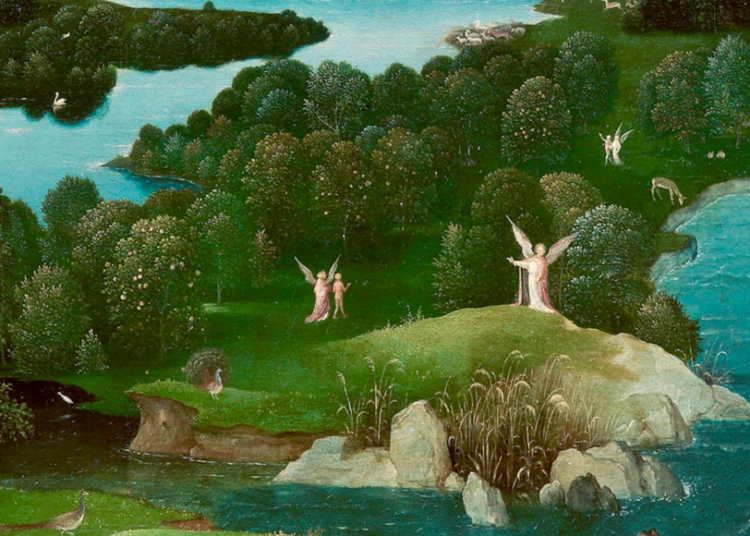Joseph Pearce’s “The Good, the Bad, and the Beautiful” is a perfect textbook for history classes in Catholic schools, homeschoolers, and anyone concerned to transmit an overview of Catholic history and culture.
The Good, the Bad, and the Beautiful: History in Three Dimensions, by Joseph Pearce (300 pages, Ignatius Press, 2023)
 The best way to study the history of the West is through the lens of Church history, because the political, military, economic, and cultural history of the West is invariably built on, and interwoven with, the fortunes and failures of the Church.
The best way to study the history of the West is through the lens of Church history, because the political, military, economic, and cultural history of the West is invariably built on, and interwoven with, the fortunes and failures of the Church.
Some years ago I produced a twenty-five part podcast for my blog called Triumphs and Tragedies. The idea was to help Catholics understand that the history of the Church has always been one of struggle and sanctity, saints and sinners, hypocrites and heroes, triumphs and tragedies. The aim was to encourage believers who were struggling with the darker elements of the Church in our own age. My message was, “Take heart. The clouds have always had a silver lining, and the shadows have always been part of the chiaroscuro of God’s great providential painting.”
I was pleased, therefore, when my friend Joseph Pearce set out to write a book with the same aim. The Good, the Bad, and the Beautiful: History in Three Dimensions is the result. Pearce’s outline and accomplishment are quite simple: Write one chapter for each of the church’s twenty centuries, and in each chapter show the reader what was good, what was bad, and what was beautiful.
The “good” being the accomplishments of the saints and the Church Militant, the “bad” being the shadow side—the sinners, the corruption, the bloodshedm and failures of the sons and daughters of the Church. The ‘Beautiful” chronicles the art, architecture, music, and literature of every age. In putting the three together in concise form, Pearce has provided us with a readable, exciting, and accessible history of both the Catholic Church and Western culture.
With extensive research and attention to detail, Pearce’s simple concept and outline are the reason his book is also concise and focused. There is no need for extended comment, interpretation, or interpolation of the author’s opinions. Just the facts, ma’am.
The Good, the Bad and the Beautiful is a perfect textbook for history classes in Catholic schools, homeschoolers, and anyone concerned to transmit an overview of Catholic history and culture. If not a textbook for every student, then at least this book should be part of the reference section of every Catholic school library. As a reference book, the student can brush up on the theology, philosophy, politics, and culture of any century. Were you wondering how the thinkers of the Enlightenment in the eighteenth century influenced the events of the nineteenth? Easy. Pick up Pearce’s book and flip to chapters eighteen and nineteen.
Curious to know how the fall of Byzantium connects with the rise of Islam? Pick up Pearce and flip to… where was that again?
And this leads me to the book’s deficiencies. The author and publishers would have done well to produce a more detailed table of contents. The general index is fine, but I suspect indexes are computer-generated these days, and a more personal, comprehensive, and easily accessed table of contents would be preferable. The book’s footnotes are ample, but a reading list at the end of each chapter would be a bonus for students. If the books on that reading list had a brief summary or recommendation by the author, even better. A glossary at the end of each chapter (or explanatory footnotes) within the text would also enhance the book’s schoolroom potential. Finally, in a book in which one third is about “the beautiful,” why was it not illustrated? Ignatius Press would do well to come out with a new “study edition,” sumptuously illustrated not only with reproductions of the art, but with maps, charts, graphs, and other visual enhancements.
 Ultimately, the success of The Good, the Bad, and the Beautiful is that it serves as a correction to those histories, theories, and ideologies that would focus only on one of Pearce’s three dimensions. Triumphalist Catholics who would focus only on the good and beautiful accomplishments of Catholicism are corrected, and harsh critics of the Church who only see crusades, oppression, inquisition,s and witch-hunts are also corrected. Instead, we are led to understand and accept the full (and often unpalatable) reality of history, and this is a form of mercy, for it is a merciful thing to accept the reality not only of history, but also of ourselves and others.
Ultimately, the success of The Good, the Bad, and the Beautiful is that it serves as a correction to those histories, theories, and ideologies that would focus only on one of Pearce’s three dimensions. Triumphalist Catholics who would focus only on the good and beautiful accomplishments of Catholicism are corrected, and harsh critics of the Church who only see crusades, oppression, inquisition,s and witch-hunts are also corrected. Instead, we are led to understand and accept the full (and often unpalatable) reality of history, and this is a form of mercy, for it is a merciful thing to accept the reality not only of history, but also of ourselves and others.
By including the bad as well as the good and the beautiful, Pearce’s book also inclines us to understand one of the profound truths of accepting reality: that the bad is nothing but the good twisted or distorted, and that is the only way Satan works. As Frodo Baggins observes when faced with the dark: “He who bred the orcs cannot make. He can only mock.” So, for example, the Inquisition was a twisted way of defending the truth, and the Crusades were a twisted way of enabling pilgrimage.
Someone has said that if “to know all is to forgive all then that explains why God is all forgiving.” Indeed, to see how the bad is the good distorted is also to see how the bad is eventually brought around to the good, and that is to begin to understand the mystery at the heart of the Christian religion: that the very worst thing— that men would murder the Son of God— turned out for their souls’ salvation. So Pearce’s book reveals how this same redemptive power is at work in and through the history of humanity in the sacrament of Christ’s Church… and if in the broad sweep of history, then also in the smaller sweep of the individual soul.
The Imaginative Conservative applies the principle of appreciation to the discussion of culture and politics—we approach dialogue with magnanimity rather than with mere civility. Will you help us remain a refreshing oasis in the increasingly contentious arena of modern discourse? Please consider donating now.
The featured image is “Landscape with Charon Crossing the Styx” (1515?) by Joachim Patinir, and is in the public domain, courtesy of Wikimedia Commons.


